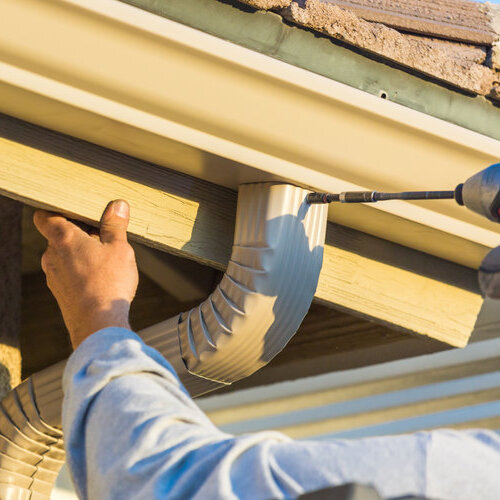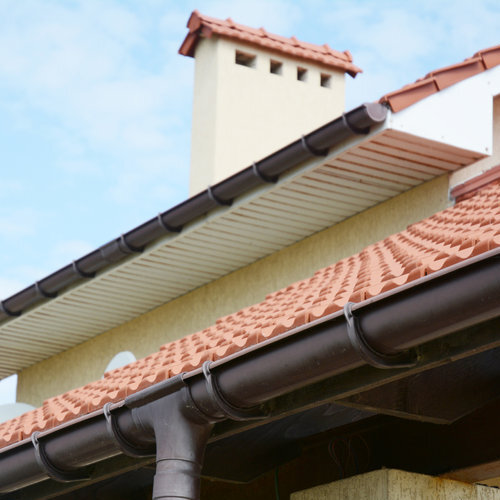
Understanding Your Roof
When you think about a roof, like most people, you simply envision the shingles or other roofing materials on top, right? Before we discuss the fascia and fascia repair, we’re going to review the other components to a roof. These are each an important part to the roof and your home. Those components consist of:
1. The Eaves – These are the roof edges that overhang vertically over the exterior wall. This keeps the rain off the walls.
2. The Gable – This is the triangle where the two eaves meet at the top of the walls. They can be located at the front, back, or sides of your house, depending on the shape and size of the structure.
3. Flashing – This is what keeps water from getting under the roofing materials in the roof valleys. It is also used around chimneys, vents, skylights, and other roof protrusions.
4. The Hip – This is found on a house without gables, has a four-sloped roof line, and allows water to run off.
5. The Ridge – This is where gables and sides come together at the top and run the roof length.
6. The Fascia Board – This is usually a wood board that is located right under the roof, with the roof lower part resting on the fascia. Some fascia boards have been made from asbestos over the years and should be replaced with new and safer material. Fascia repair is important to the entire roofing structure.
7. The Rafters – This is the roof structure’s key component, working with the joists and purlins. This is the framework that creates the roof before roofing materials are ever installed and will be placed side by side during the construction of the roof.
8. The Battens – This is the roof’s fixing point for roofing materials. Without this, if a tile were to slip, a gap would be left for water to enter.
9. The Gutters – This is usually an aluminum or vinyl pipe-like item that goes around the roof under the eaves. It collects rainwater and directs it to the downspout. The Fascia board for gutters is extremely important, making fascia repair an urgent matter when damage or rot is noticed. Often, fascia board and gutter replacement are done at the same time.
10. The Downspout – This is attached to the gutter run, is installed vertically, and sends the rainwater from the gutter out and away from the house foundation.
How important is fascia on a house?
The fascia board is mounted where the roof and outer walls meet on your house. It is a finishing trim, attached directly to and connecting the rafters and truss ends. It often provides support for the bottom row of tiles and is where the gutter runs are attached. Fascia boards are made of:
- Aluminum
- Plastic
- Vinyl
The purpose of the fascia board is to block water from getting inside your home and under the roof. It provides safety for the roof and the interior of your home from moisture by blocking it from entry while providing an aesthetic touch to your home’s architecture.
When water gets behind the fascia, it becomes susceptible to further damage that can continue on to the other roofing components. Having a drip edge along the roof’s edge just under the first row of shingles deflects water away from the fascia board. If the fascia repair isn’t done and the water issue isn’t resolved, this leaves your roof susceptible to critters and insects entering your house through the attic.
Who repairs fascia board?
Fascia repair can be done by a roofing contractor or general carpentry contractor. Some painters are able to make minor fascia repairs while painting your home. A handy DIY homeowner can do their own fascia repair following the instructions from several YouTube videos.
Why is fascia board grooved?
To help them connect to the soffit, the house, and each other for better stability. If using plain wood for the fascia, J-Hooks are used to replace the groove of other soffit materials.
What is the best material for fascia boards?
Wood has been found to be the best material for fascia boards. When it is properly implemented with the ideal roof covering, it is aesthetically complete while being resistant to the elements. When installed correctly, the fascia complements the overall architecture.
Can you replace fascia and soffit?
When it comes to the fascia board vs soffit, is one more important than the other? No – both are equally important to your home’s roof, and both will need your attention for damage. Soffit and fascia repair is important and these items should be inspected by you at least once a year.
During your inspection, you want to ensure the materials of both are in good condition – are they caulked, sealed, and painted? If not, yes, both can be replaced, and most times it is best to replace both but this isn’t always necessary.
Depending on your home’s size, the construction material of the fascia and soffit, and the damage done, the soffit and fascia repairs can be as little as $20 per linear foot. Replacement of either can run around $30 per linear foot. Consider this an investment in the protection for your home.
How is fascia board attached?
The fascia board is fastened to the rafter ends by nails. A tip is left out for the soffit to be installed and all are attached to the batten that has been attached to the exterior of the home.

Topping It All Off
At the end of the day, or the end of the rafter, the soffit and fascia repairs are important not only for the aesthetics but the stability of your home, too. In the case of homeowner’s insurance, many companies won’t cover the roof until these are repaired. In need of a bit of help with your home’s fascia? Reach out to the Affordable Gutters Plus LLC team by calling 770-735-4433.
